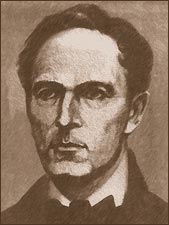Karl Theodor Seydel

Karl Theodor Seydel (born July 14, 1812 in Minden ; † January 9, 1873 in Berlin ) was a Prussian civil servant and Lord Mayor of Berlin from 1863 to 1872 .
Live and act
Civil service career
He was the son of a landowner. After attending school in Cologne , he studied political science in Königsberg . He then returned to Minden, where he also did his military service in the Landwehr . He then entered the Prussian administrative service ( Minden district ) as a government referendar there in 1833 . In addition, he conducted philosophical and philological studies.
In 1839 he became a government assessor . From 1841 he was an unskilled worker in the Prussian Ministry of Finance. After he had published something in an opposition newspaper, he was transferred to Opole after disciplinary proceedings . A short time later he returned to Berlin. In 1844 Seydel became commissioner for the Upper Silesian Railway . A year later he was appointed to the government of the Prussian Ministry of Finance and Maritime Trade .
There followed a steady rise in the ministry. Seydel became a secret finance councilor in 1847, a lecturing councilor in 1850 and a secret upper finance councilor in 1854. As such, he was responsible for money and credit matters as well as coinage. In 1859 he became regional president of the Hohenzollern Lands, which had come to Prussia only a few years before, and was based in Sigmaringen .
Lord Mayor in Berlin
After the resignation of the mayor of Berlin, Heinrich Wilhelm Krausnick , the city council proposed him as his successor. After some negotiations, including about his salary, Seydel accepted. He was elected on May 15, 1862 with 72 of 91 votes, but was not officially introduced into office until January 12, 1863 .
The beginning of his term of office was overshadowed by the Prussian constitutional conflict . This also led to political contradictions in the city council . Seydel himself was considered conservative, but had no interest in party political disputes. Nevertheless, his ideas and initiatives led to conflicts, especially with the liberal city councilors. His private life also suffered as a result. The relationship with his brother-in-law Rudolf Virchow was temporarily disturbed. After the end of the constitutional conflict in 1866, the political contradictions also subsided in Berlin's local politics.
One of Seydel's sustainable achievements is the preparation for the construction of a modern sewer system. James Hobrecht was commissioned with this . However, the construction itself was not started until 1873. In the field of transport, the old wooden lifting bridges over the Spree were replaced by modern stone bridges , which no longer hindered ship and road traffic. In place of the Berlin city wall , which was demolished in 1865 , new streets were built. Seydel implemented the first horse-drawn tram line in local passenger transport . He also devoted his attention to improving the health system. So he enforced the decision to build the first large municipal hospital on Friedrichshain . He particularly promoted education. Elementary and secondary schools as well as schools for senior daughters were set up. In 1864 the first gymnasium was also built. In addition to the zoo, the Treptower Park and the Volkspark Humboldthain were created for the recreation of the population. The completion of the Red Town Hall also fell in Seydel's time .
His work was affected by serious health problems, so that he gave up his office in 1872.
death
Karl Theodor Seydel died in January 1873, just a few months after leaving the office of Lord Mayor, at the age of 60 in Berlin. He was buried in the St.-Matthäus-Kirchhof in Schöneberg . The grave has not been preserved.
literature
- Götz Langkau , Hans Pelger : Studies for the Rheinische Zeitung and its demand for freedom of trade and basic rights in the German Confederation, with a letter from Karl Marx to Hermann Müller-Strübing (1843). Trier 2003, p. 175 ff. ISBN 3-86077-848-X . (= Writings from the Karl-Marx-Haus issue 51)
Web links
Individual evidence
- ↑ Rainer Paetau , Hartwin Spenkuch (edit.): The protocols of the Prussian State Ministry 1817–1934 / 38. Vol. 6 / II. In: Berlin-Brandenburg Academy of Sciences (Hrsg.): Acta Borussica . New episode. Olms-Weidmann , Hildesheim 2003, p. 710. ( Volume 6 / II ; PDF 1.9 MB).
- ^ Hans-Jürgen Mende: Lexicon of Berlin tombs . Haude & Spener, Berlin 2006. p. 309.
| personal data | |
|---|---|
| SURNAME | Seydel, Karl Theodor |
| BRIEF DESCRIPTION | Prussian civil servant and Lord Mayor of Berlin (1863–1872) |
| DATE OF BIRTH | July 14, 1812 |
| PLACE OF BIRTH | Minden |
| DATE OF DEATH | January 9, 1873 |
| Place of death | Berlin |

